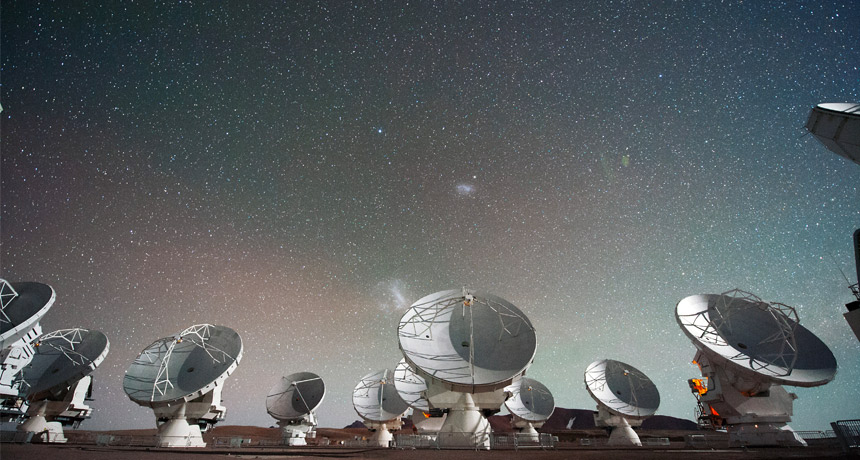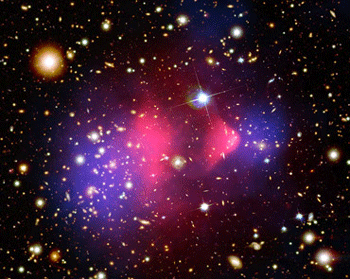Distant galaxy seems filled with dark matter
Earlier studies suggested such mega-clusters of stars would lack the dark stuff

With these telescopes of the Atacama Large Millimeter/submillimeter Array in Chile, astronomers discovered the most distant galaxy that seems to be filled with dark matter.
C. Malin/ESO
Cosmic Seagull is a galaxy — a massive community of stars — some 11.3 billion light-years away. This galaxy also hosts a mystery. Its outermost stars race way too fast to be propelled just by the gravity of the galaxy’s gas and stars. Instead, they move as if urged on by an invisible force. And that appears to point to the presence of dark matter, scientists now report.
Most of the universe appears to be filled with dark matter, a mysterious, unseen material. Astronomers know it exists by the way its mass interacts — via gravity — with visible matter.
If the Cosmic Seagull is one such repository, it will be the most distant galaxy to be filled with dark matter.
Verónica Motta works at the University of Valparaíso in Chile. This astrophysicist and her colleagues shared their new findings August 8 at arXiv.org.
“In our nearby universe, you see these halos of dark matter around galaxies like ours,” she says. “So we should expect that in the past, that halo was there, too.” And because the light from distant galaxies is just reaching us from long, long ago, these new data point to the presence of dark matter back in those very ancient times.
Motta and her team used radio telescopes in Chile. They’re known as ALMA, which is short for the Atacama Large Millimeter/submillimeter Array. These telescopes have measured the speed of gas across the Cosmic Seagull’s visible disk, which spans out from the center across a distance of about 9,800 light-years. ALMA’s findings show that the galaxy’s stars speed up the farther they get from the galaxy’s center.
That’s a strange setup for most orbiting objects. When planets orbit a star, for instance, the most distant planets move the most slowly. But the Cosmic Seagull’s gas speeds can be explained if the galaxy’s far reaches are dominated by dark matter, which speeds things along.
New data challenges some earlier ones

Similar measurements of the Milky Way and its neighboring galaxies provided one of the first signs that dark matter may truly exist. But those data can’t reveal what dark matter is actually made of. Physicists still are still trying to detect directly the proposed particles that make up dark matter.
The new finding by Motta’s team does challenge one recent claim. Last year, researchers reported such distant galaxies are oddly lacking in dark matter. Astronomer Reinhard Genzel of the Max Planck Institute for Extraterrestrial Physics in Garching, Germany had led a team looking into the issue. More than 100 distant galaxies keep their slower stars at the edges and faster stars closer in, they found. That means these galaxies would have required little to no dark matter.
The report by Genzel’s group “has been viewed with both excitement and skepticism,” says Richard Ellis. He’s a cosmologist at University College London who was not involved in either study. “It makes a lot of sense for others to examine galaxies at these [distances] in different ways,” Ellis now concludes.
Motta and her colleagues were able to focus their probe of dark matter thanks to a massive galactic train wreck. Called the Bullet Cluster, this cosmic collision acted like a huge telescope. Cosmic Seagull lies behind the Bullet Cluster (at least from Earth’s perspective). The cluster’s mass alters the Seagull’s light in a phenomenon known as gravitational lensing.
Indeed, that distortion earned the disk-shaped galaxy its name: The first images of it had reminded Motta’s team of the seagull logo for a popular music festival in Viña del Mar, Chile. More importantly, that distortion magnified the galaxy’s light 50-fold — a new record.
The Motta team “have exquisite data,” Ellis wrote in an e-mail. Their observations, however, are limited. For instance, the team looked at only one galaxy. And that galaxy is much smaller and less massive than those that seem to host little dark matter. What’s more, the telescopes’ observations don’t cover the entire galactic disk. That means that stars beyond what the team could view may be slower than those they were able to see.
Motta agrees that a distant slowdown is possible. Still, she notes, her observations cover the same portion of the Cosmic Seagull’s disk as had the study of galaxies that seemed short on dark matter.
“We are roughly at the place in which we should see the turning point,” if it exists, from fast to slow stars, she says. To be sure, “we need to extend the study.” In fact, her team has been granted more time with ALMA next year to keep looking.







